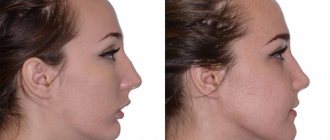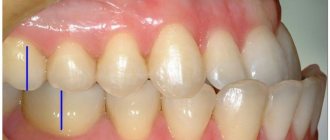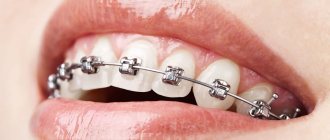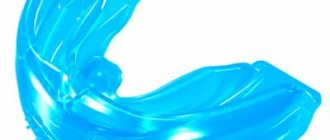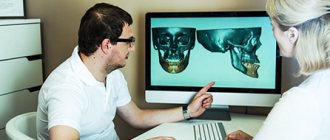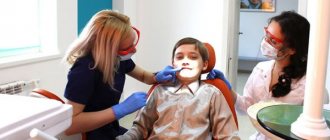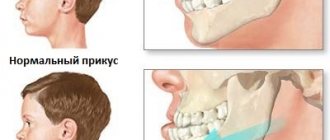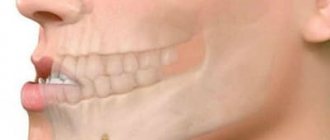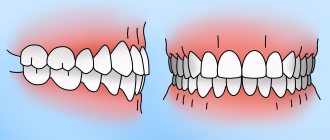Publication date: June 28, 2021.
Date the information on this page was updated: September 04, 2021.
An open bite is a type of malocclusion in which the upper and lower dental arches do not partially meet each other in the anterior or posterior regions. When closed, a gap forms between the teeth, which interferes with normal biting and chewing of food, and sometimes does not allow the lips to be completely closed. Open bite most often occurs in children under one year of age. With age, the likelihood of acquiring an anomaly decreases.
Signs of an open bite
An intraoral sign of an open bite is the lack of contact between the upper and lower teeth when attempting to occlude. The dentition may be narrow and malocclusion is accompanied by crowding. Sometimes such a bite is characterized by elongation of the lateral teeth. The teeth tend to close despite the anomaly, since this is their natural position, and therefore lengthen.
An open bite can often be identified by the face: the lower third is enlarged, the nasolabial folds are smoothed. The mouth may be slightly open, since the lips cannot close, and when closed, the lips are very tense. Also, patients with an open bite may have an increased tongue size. An open bite also affects speech and diction: the owner of such an occlusion may have a lisp or not pronounce certain sounds. But in adulthood, a person, as a rule, adapts, so poor diction is an optional sign of an open bite.
Correction
The bite correction program is selected by the doctor depending on the patient’s age and the severity of the pathology.
Correction methods for primary occlusion:
- Myogymnastics.
- Electrical stimulation.
- Increased occlusal load.
Orthodontic devices are selected individually. These can be plates, trainers, mouthguards, arches. I use vestibular plates to wean a child from bad habits. Expansion plates are necessary to correct pathological jaw development.
Treating open bite in adult patients is difficult. The doctor selects orthodontic structures, Engle devices, braces, mouth guards, orthodontic crowns. In the most difficult cases, surgical treatment is also required. Depending on the characteristics of the pathology, it is necessary to remove some teeth, shorten the crown part, etc.
The easiest way to treat the false form of the anomaly. The purpose of the correction is to promote the normal development of the maxillofacial apparatus. Thanks to this, the external manifestations of the defect are gradually eliminated.
Need an orthodontic consultation? Come to the Zuub.rf clinic. After examination and diagnosis, the doctor will assess the condition of the maxillofacial apparatus, give recommendations for prevention or prescribe treatment.
Types of open bite
An open bite is classified according to its position in the oral cavity: anterior - when the front teeth do not close, and lateral . Lateral open bite can be unilateral or bilateral.
Open bite in the anterior region
Open bite in the lateral region
According to the causes of occurrence, rachitic (true) and traumatic (false) open bite are divided.
A rachitic open bite is the result of improper growth and development of the jaws and dental tissues: they are deformed due to a lack of essential minerals. This form of occlusion is less susceptible to correction and may require surgical intervention.
Traumatic open bite is formed due to bad habits (placing objects or tongue between the teeth), early loss of baby teeth, throwing back the head during sleep.
Causes of disocclusion
The causes are divided into congenital and acquired. Difficulties during pregnancy and genetic characteristics are a common cause of disocclusion. This provokes a violation of the position of the tooth buds. After the birth of a child, the following factors can be identified that contribute to disocclusion:
- lack of vitamins, minerals and other nutrients, which led to rickets and body disorders;
- prolonged nasal congestion due to inflamed adenoids, polyps, rhinitis, deviated nasal septum;
- bad habits of a child - sucking a finger, lips, toys, sticking out the tongue between the teeth, biting nails.
The cause is also a variety of dental problems, for example, late teething or early loss. Congenital anomalies also play an important role in the formation of malocclusion. Treatment of open bite in children is most effective up to 5 years of age, when bone tissue is actively forming. At 6-7 years old, removable systems can be used for correction; for adolescents, treatment is carried out after the appearance of all molars.
Need some advice?
Enter your phone number and we will give you a free consultation
I want a consultation
*By making an appointment you consent to the processing of your data
Causes of open bite
A child may be born with an incorrect bite caused by heredity or illnesses of the mother, or may acquire it as a result of childhood illnesses or incorrect habits. The main causes of malocclusion:
- Diseases and lack of minerals: rickets, metabolic disorders affect the development of the dental system. Bones and tissues do not receive enough of the necessary “building material”, become deformed and grow incorrectly.
- Respiratory diseases: rhinitis, sinusitis, adenoids interfere with natural nasal breathing. While the child breathes through his mouth, his mouth is constantly open, and his tongue is inserted between his teeth. With regular mouth breathing, this position of the teeth and tongue is fixed, forming a gap between the front teeth.
- Bad habits: constant sucking on pacifiers, fingers, toys prevents teeth from closing on each other. The teeth close on a foreign object and remain in the wrong position.
- Shortened frenulum of the tongue.
- Increased tongue size.
- Infantile type of swallowing is a swallowing mechanism in children under two years of age in which the tongue is located between the gums. If this type of swallowing does not change to somatic, then the incorrect position of the tongue interferes with the normal growth of teeth.
Symptoms
It is impossible not to notice the presence of this pathology, since its signs are very bright and pronounced. All symptoms are usually divided into 3 groups.
Facial disorders:
- The lips do not contact each other, the mouth is always slightly open, and the teeth and sometimes the tip of the tongue are visible through the gap.
- There is constant muscle tension around the mouth, the nasolabial fold is smoothed.
- The lower part of the face is elongated, the chin is curved.
Intraoral disorders:
- There is a pronounced gap between the teeth.
- Since the mouth is always slightly open, the mucous membrane dries out, becomes swollen, and bleeds.
- The teeth in the smile zone are crowded and overlap each other.
- There is a risk of developing diseases of the nasopharynx, larynx, and hypoplasia.
Functional disorders:
- Difficulty biting food, chewing, swallowing.
- The patient cannot breathe through his nose, so breathing is predominantly oral.
- The temporomandibular structure functions poorly, diction is impaired.
Consequences of an open bite
Any malocclusion affects the aesthetics of the smile and face and the functionality of the dental system.
Aesthetic problems of an open bite are a gap between the teeth, irregular shape of the lips, a violation of the proportions of the face - an increase in the lower third, a surprised expression on the face.
With open occlusion, some teeth do not perform their direct function - biting and chewing food. Teeth, which bear the entire chewing load, are quickly destroyed and worn out. At the same time, due to poor quality of chewing food, the entire digestive system suffers. Uneven load on teeth causes periodontal diseases: bleeding gums, inflammation and can lead to early tooth loss.
Which teeth bite is not considered correct?
The presence of deviations from the norm is at least the basis for a dental diagnosis, based on the results of which a decision is made on the need for treatment. The best option is orthodontic correction in childhood, since the dentofacial apparatus, which is in the stage of formation, is more easily amenable to the targeted influence of a special machine and takes on the desired structure without surgical intervention. The most commonly diagnosed abnormal forms have certain signs that allow us to understand whether a person’s bite is correct or not, what is going wrong, and how this deviation can affect the further development of the jaw:
- Distal - diagnosed with excessive development of the upper jaw, noticeably protruding forward and distorting facial features.
- Mesial is a reverse pathological condition in which the mandibular row protrudes, almost completely covering the incisors and canines.
- Cross - characterized by the presence of free areas between the teeth, as well as a “scissor” intersection of elements in a random order.
- Deep - significant, more than 30%, overlap of the lower section.
- Open - contact during closure is observed only between individual chewing units, while in the incisal region there are pronounced gaps, creating the impression of a constantly slightly open mouth.
Any pathological manifestation requires timely medical intervention. Not all patients know what a correct bite in a person is and what it is needed for - but this indicator affects the quality of respiratory and speech function, ensures the conditions for normal food processing and the functioning of the gastrointestinal tract. By contacting Dentika dentistry, you can undergo a comprehensive diagnosis, receive recommendations from qualified specialists and, if necessary, resort to orthodontic correction services.
Treatment of open bite in children
At an early age, to correct an open bite, it is important to eliminate the causes of its occurrence. To wean from incorrect habits such as putting the tongue or objects between the teeth, devices are used that fix the tongue in the correct position: an orthodontic pacifier, a plate with a tongue barrier.
It is also important to restore nasal breathing and proper muscle function. Myofunctional trainers are used for this. For respiratory diseases, consultation and treatment with an otolaryngologist is necessary. To correct muscle function, in addition to the apparatus, myogymnastics is prescribed - a set of exercises to be performed regularly.
Bite correction is carried out using removable devices (Herbst apparatus, Frenkel apparatus, Klamt activator), which are selected by an orthodontist.
Diagnostics
In addition to a visual examination, the orthodontist can measure the gap and assess the degree of open bite for further treatment. There is a possibility of direction for more in-depth research that will give a complete picture:
- teleroentgenogram;
- orthopantomogram;
- taking impressions.
Often a specialist sees the presence of a combination of disocclusions: distal open bite, mesial.
To collect information about the patient and the progress of the correction, before and after photos are taken.
Treatment of open bite in adults
In adults, braces or aligners are used to correct an open bite. To obtain the desired result, cooperation between the patient and the doctor is necessary: the doctor monitors the progress of treatment, activates the equipment, and the patient must strictly follow the recommendations - follow the activation schedule and wear elastic bands. In addition to installing devices, the doctor may prescribe exercises for normal muscle function and correct tongue position. Some patients have buttons installed on the inner surface of the teeth to prevent the tongue from resting on the front teeth and causing them to move.
Treatment with orthodontic equipment usually lasts 1.5-2.5 years, depending on the complexity of the case. After removing braces, a long retention period is required - wearing permanent retainers and night guards to fix the result. Sometimes an open bite in the lateral regions can be corrected with the help of prosthetics - installing onlays on the teeth for proper closure.
Prevention
Prevention of acquired open bite will include:
- Getting rid of bad habits. Habits such as thumb sucking or chewing on a pen or pencil can cause a change in bite.
- Timely weaning of the child from the pacifier. Children over 3 years old should not be given a pacifier.
- Controlling the baby's breathing. It is important to ensure that he breathes through his nose and not his mouth.
- Monitoring the general health of the baby. All diseases, especially those of the ENT organs, must be treated in a timely manner and prevent them from becoming chronic.
- Prevention of rickets. Complications after rickets very often provoke pathological changes in the maxillofacial apparatus.
- Regular visits to the pediatric dentist for caries treatment. Preventive dental examinations allow you to notice changes in time and correct your bite.
We recommend more than just visiting your dentist regularly. During the period of changing teeth, a false form of malocclusion may occur, so it is better to show the baby to an orthodontist.
Doctors at our clinic
Shmatov Konstantin Vladimirovich
More about the doctor
Shalygin Andrey Viktorovich
More about the doctor
Kim Yulia Vyacheslavovna
More about the doctor
Reviews from our patients
Vladislav Topalov
I want to share a miracle with you. Yes Yes. MIRACLE. In 2021 I had my wisdom tooth removed. If anyone remembers, I wrote about it. Then I had to remove 3 more... and, as always happens, I gave up on it... a year and a half passed and I was told, as in the case of the first one, that I urgently needed to remove another one. And I decided that I was not ready to remove 3 more, one every year and a half. I called Kostya and asked him to delete 3 at once!!! Yes Yes! 3 at once! Under anesthesia. The operation was scheduled for 9.01. That is, yesterday. I’ll say it right away! Both then and now I PAID FOR EVERYTHING. I SHARE with YOU from the bottom of my heart, and not because they are doing something for me for free!!!! I, like 99% of us, am afraid of the dentist. I’m not afraid, of course, because I understand technology, anesthesia, etc.... but I'm afraid. Guys!!! I'M HAPPY! Yesterday, 3 teeth were removed in 15 minutes. Under sedation!!! I slept like a baby! Moreover - NOT A SINGLE SEAMLESS. Nothing hurts today. The face is NOT swollen. You can see it in the photo. I came today to see the doctor. If anyone needs to have their teeth removed - I PERSONALLY tell you - go to Konstantin Vladimirovich! He has GOLDEN hands!! Ahhh yes! I also DO NOT TAKE ANALGESICS!!! Yes, yes, you didn’t think so!!! He removed it so delicately that it doesn’t even hurt. Do you believe this? I'm not very... and all mine too. It is fantastic! Kostya, dear! God grant you health!!! Thank you so much!
Review on Instagram Read other reviews

